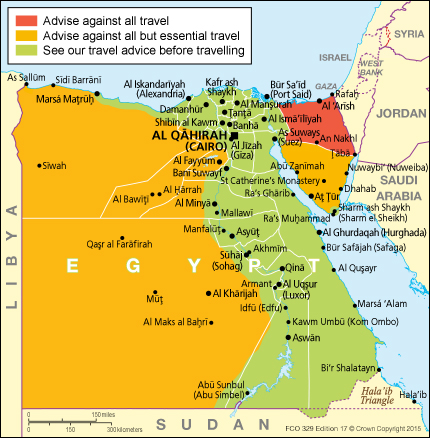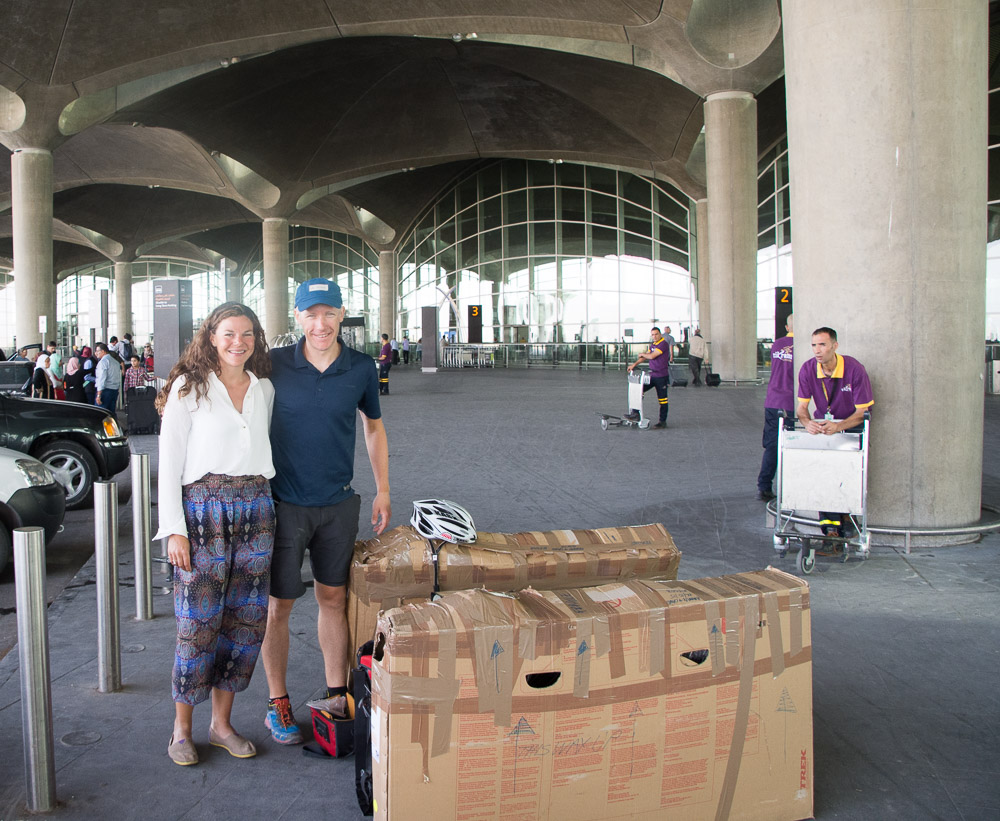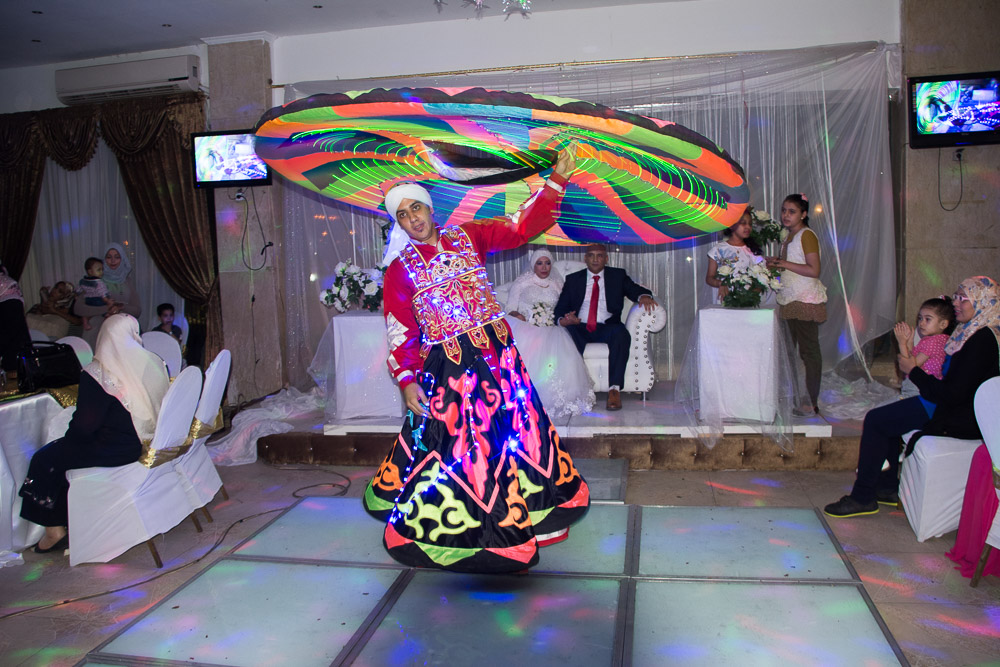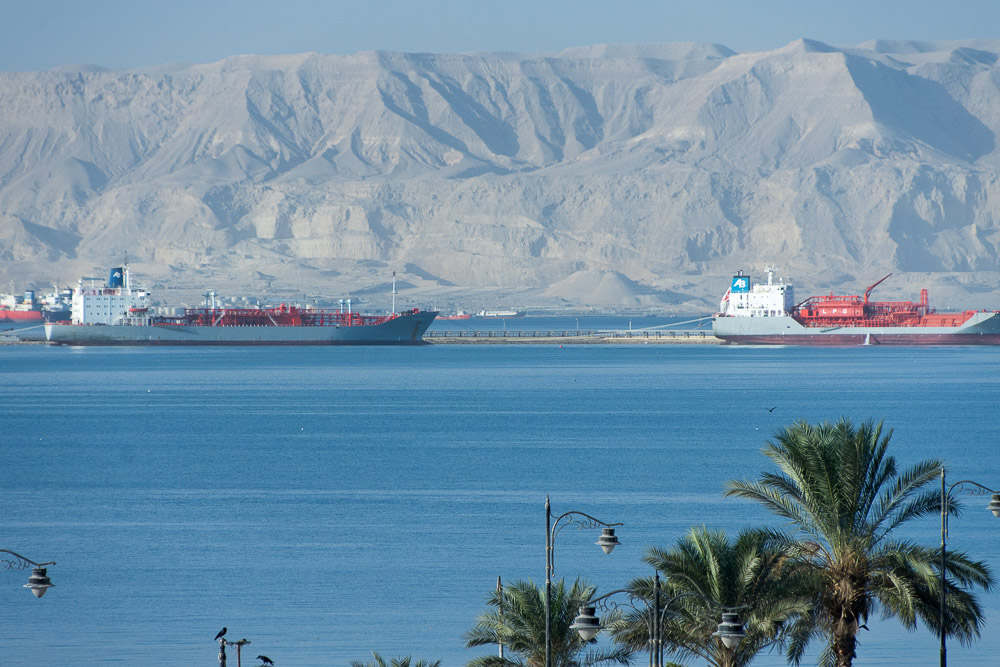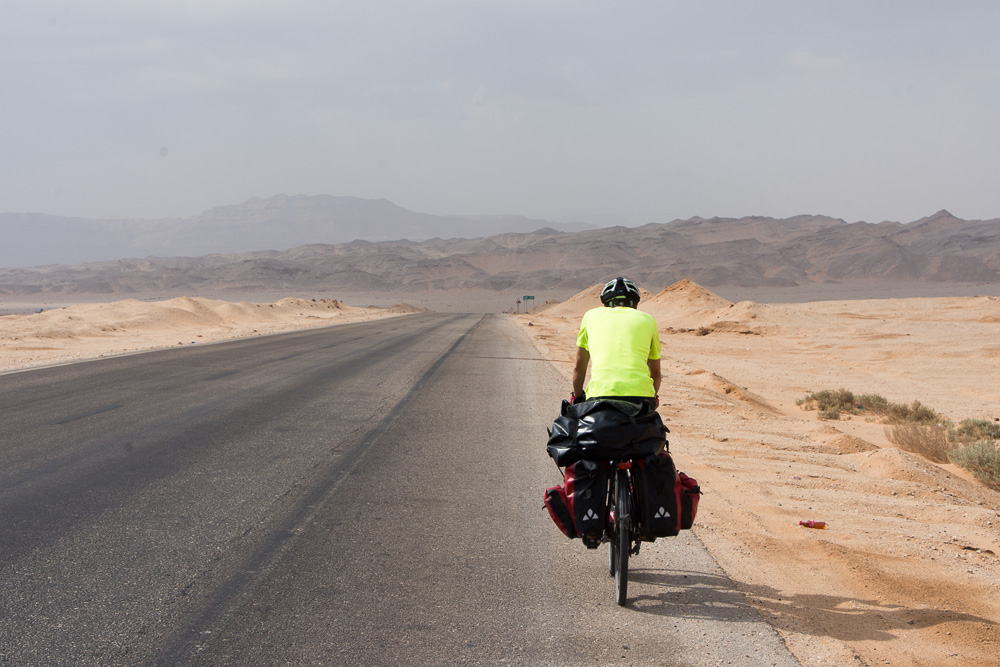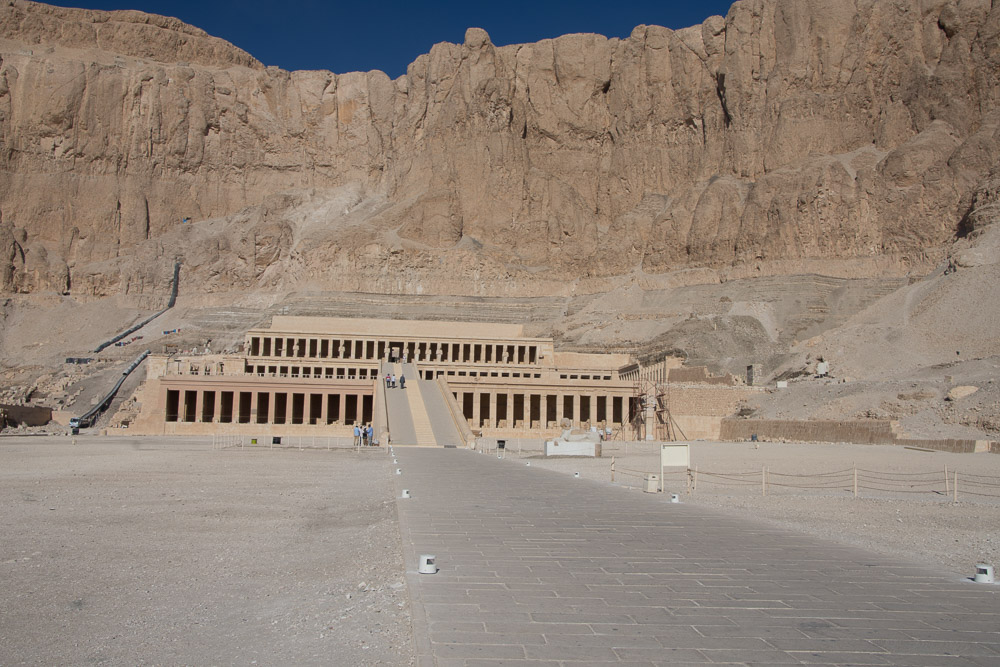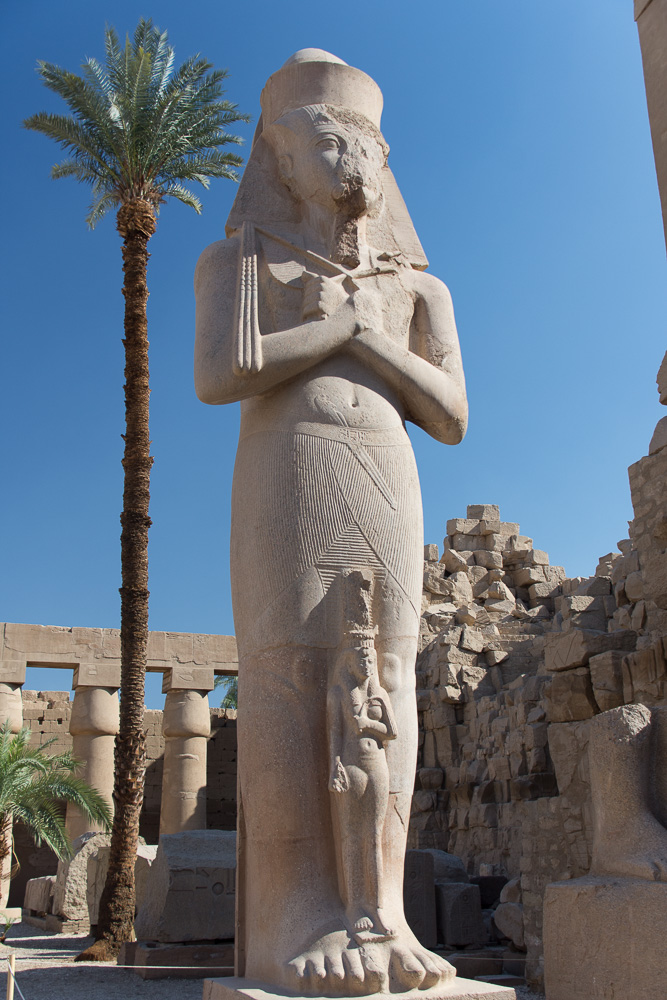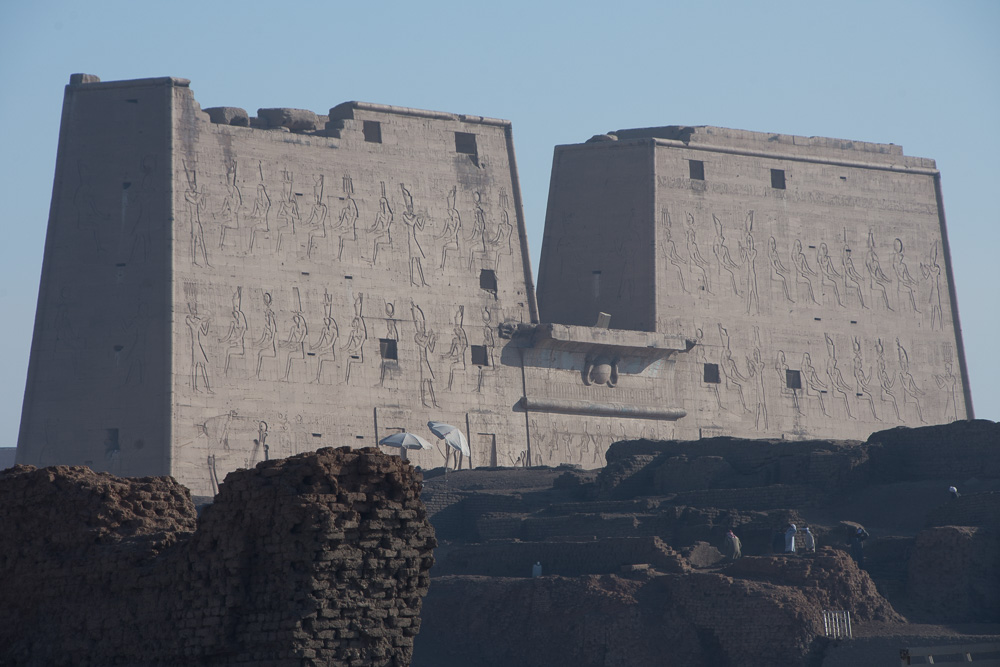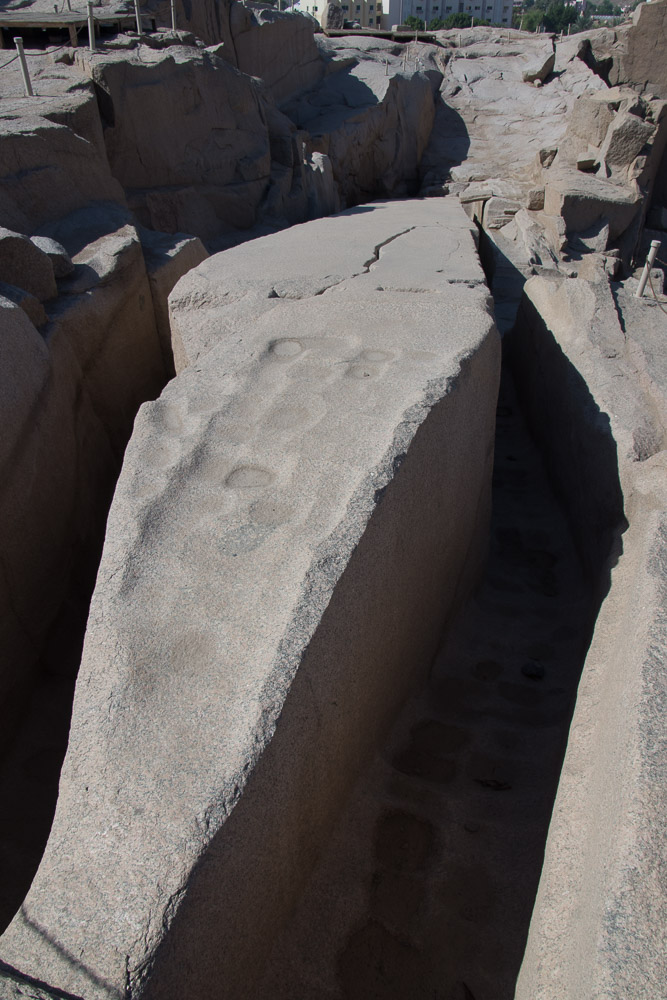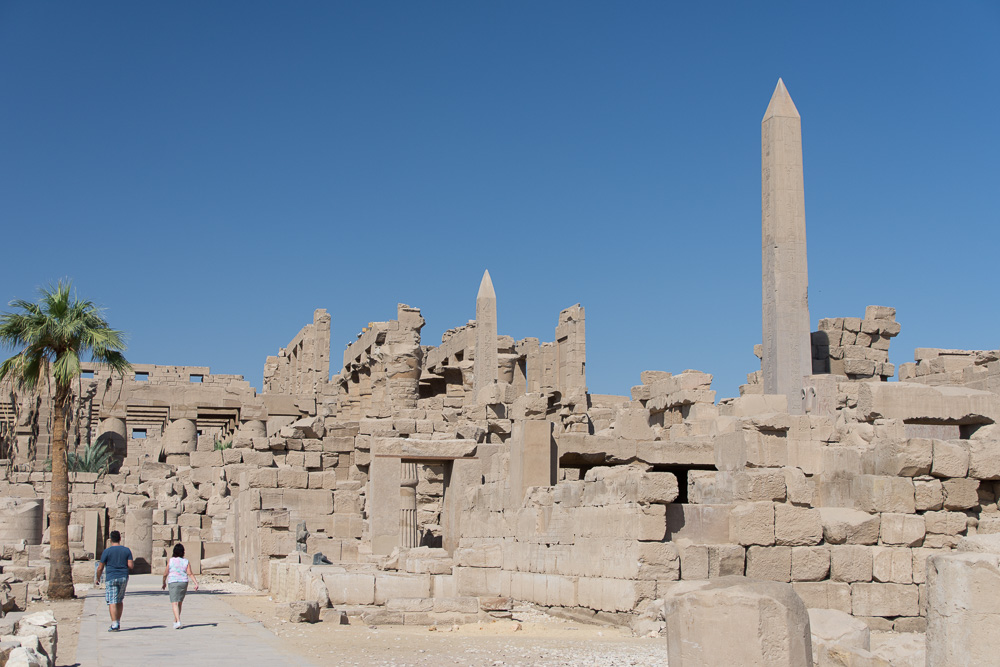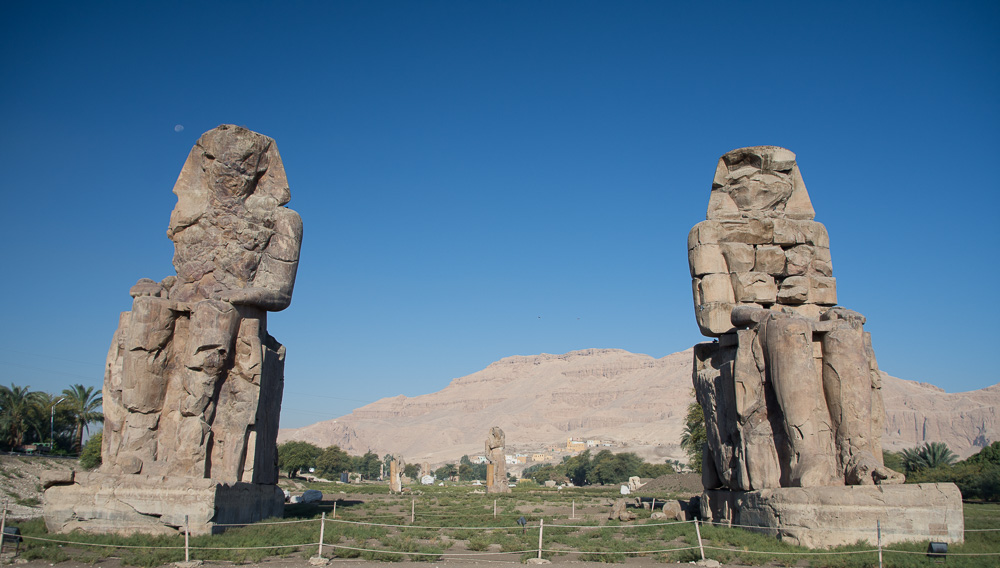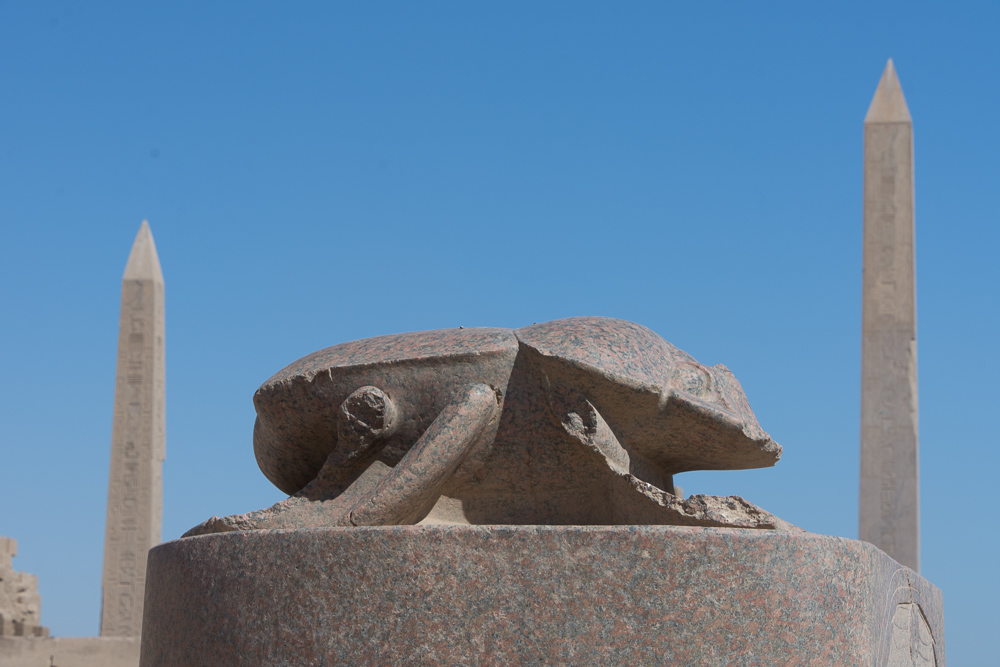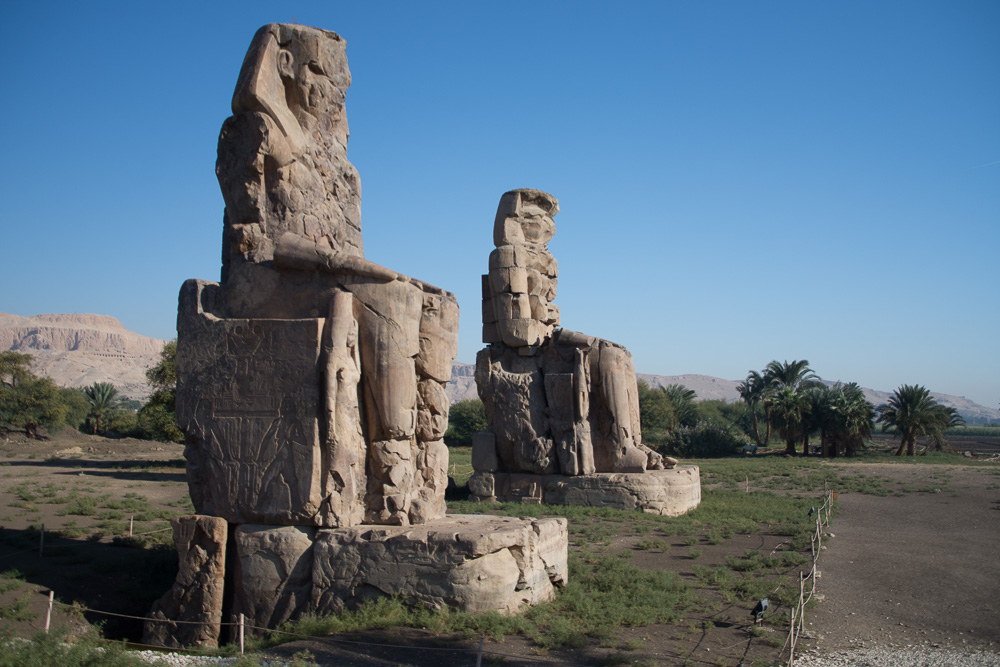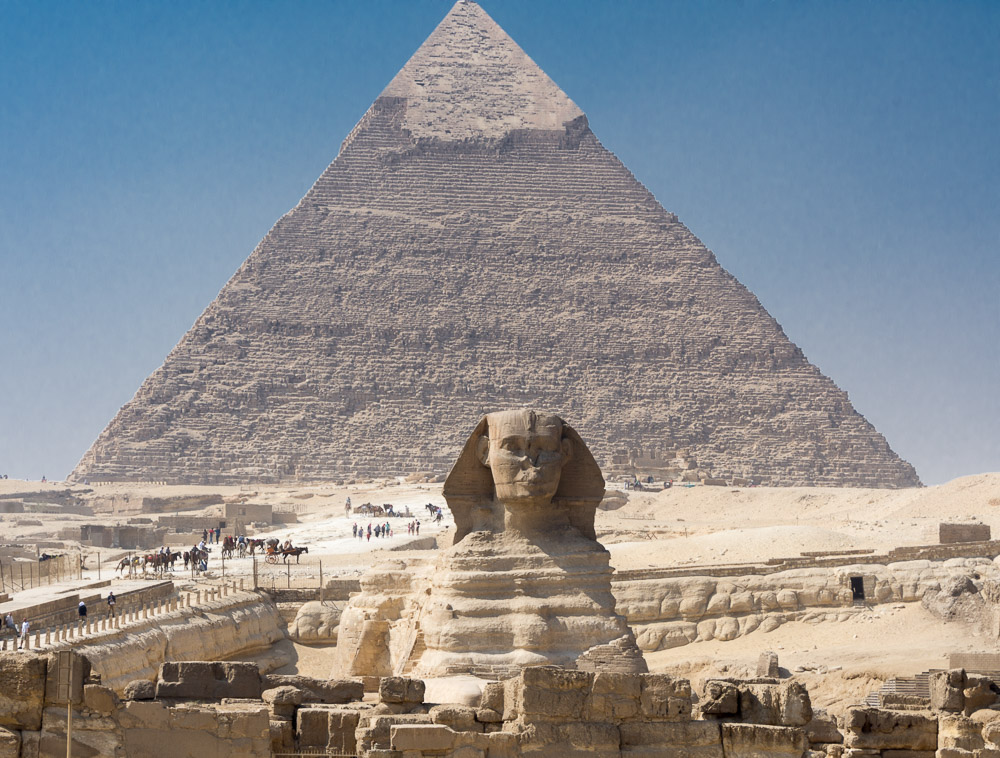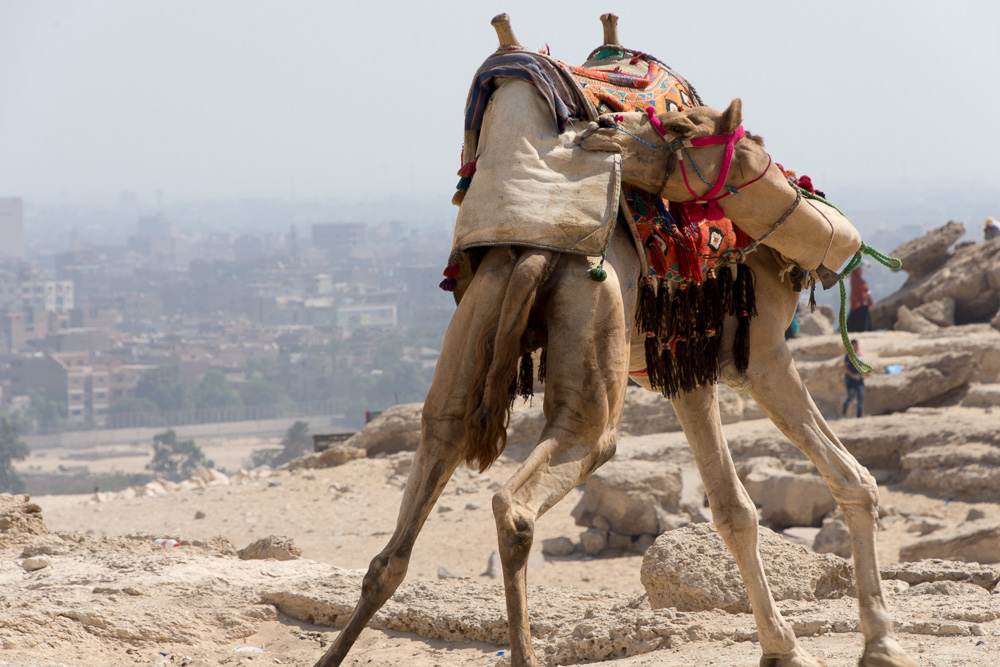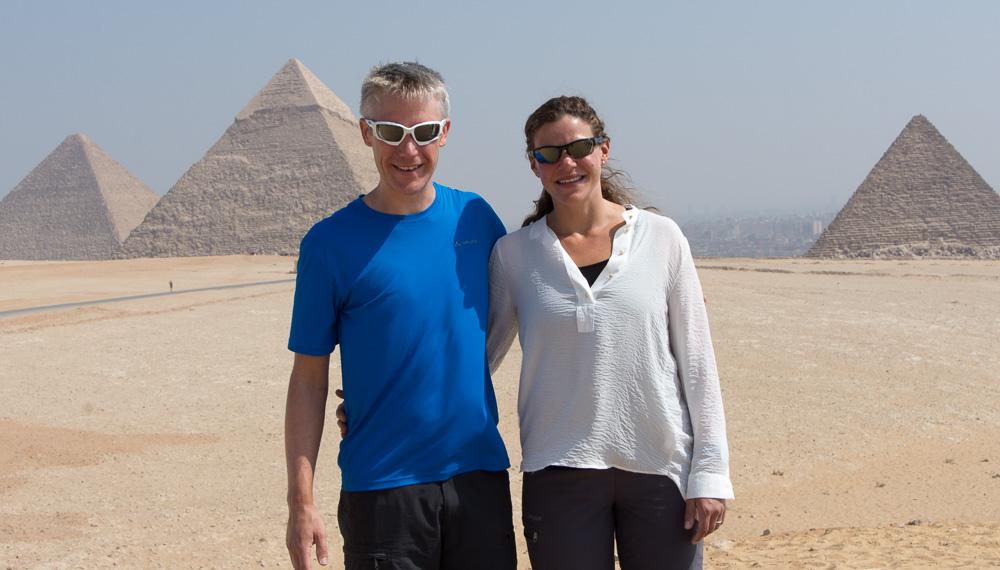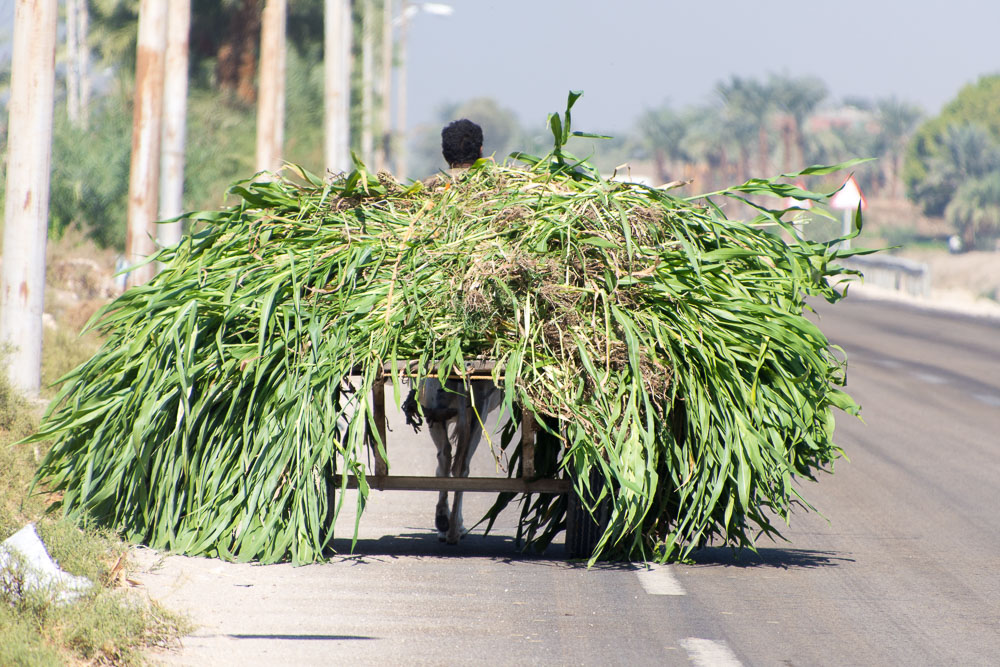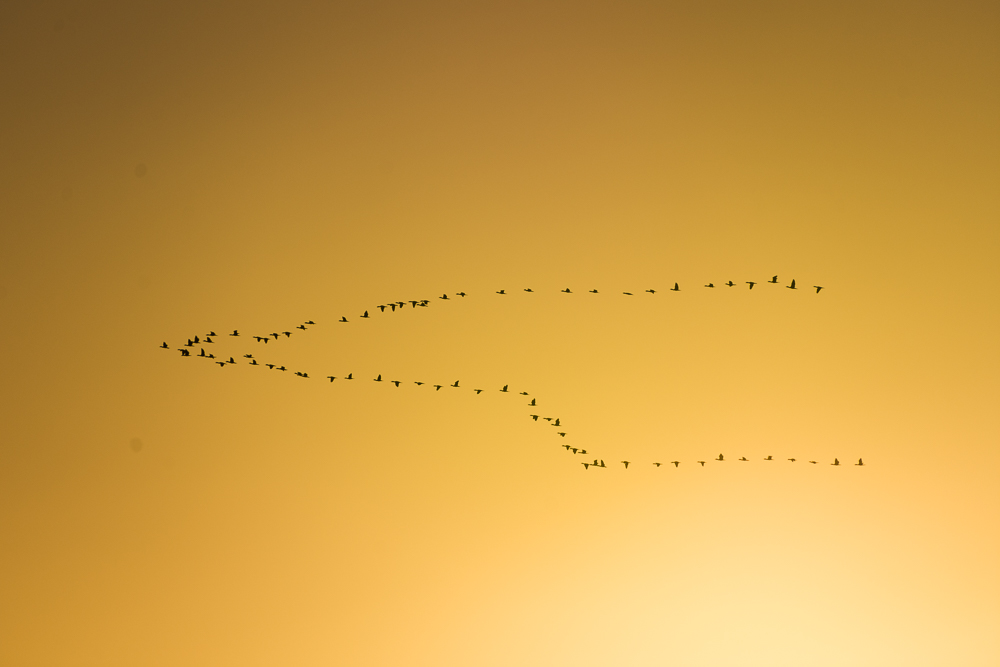Cycling Egypt: From Cairo to Aswan by bike
Reluctantly, we made the decision to fly from Jordan to Cairo because, had we cycled, our route would have taken us straight through the Sinai peninsular. The troubles in the Sinai have mostly been limited to the north east of the peninsular, close to the border with Gaza, where groups who’ve pledged allegiance to ISIS hang out but there have also been attacks near the border with Jordan at Taba in the southeast. We could have cycled the coastal road to Sharm el Sheikh and then up to Suez but even that would have taken us into a zone that the UK FCO (Government) advise against all but essential travel, which would leave our travel insurance null and void if we were to do so much as break a toe. We imagine this map may change again after recent events in the region.
The security procedures at Amman airport were a shambles. The guards manning the scanners took pleasure in picking out westerners and we saw them popping pills out of blister packs and losing an American couple’s passports. They took particular interest in our Goal Zero power pack and, for nearly 45 minutes, we thought we were going to be forced to sacrifice a piece of equipment we are reliant on when travelling in remote areas. They soon got bored of our Goal Zero and decided that, in fact, the biggest problem was our cycle helmets. It took a further 30 minutes of negotiations with numerous security staff to convince them of their importance and that they posed no threat to our fellow passengers! Upon arrival in Cairo, the builder’s bag holding my panniers had been opened and I later discovered our Victorinox knife was missing.
Our task in Cairo was to get our visas for Sudan. We couldn’t get the Sudanese visa before we left the UK because it has a 2-month validity and we arrived in Cairo exactly 3 months to the day that we departed on the London to Brighton charity cycle ride.
Our guidebook and other bloggers had suggested it would take just 48 hours to get our visas from the Sudan embassy in Cairo. In reality, we were subjected to a level of bureaucracy, incompetence and indifference that I’d never experienced before. I shall publish a separate blog at a later date about our experiences attempting to obtain Sudan visa in Cairo so as not to compromise our efforts to reapply in Aswan or spoil our time in the country…if me make it in.
In Cairo, we met with Dr Azzam, the Head of the African Cycling Federation. Dr Azzam was fresh off the plane from the UCI Gala in Abu Dhabi where he’d presented Chris Froome with an award recognising his Tour de France win. Acknowledging that two touring cyclists from London are in the same league as Froome, he presented us with our own award from the Egyptian cycling Federation.
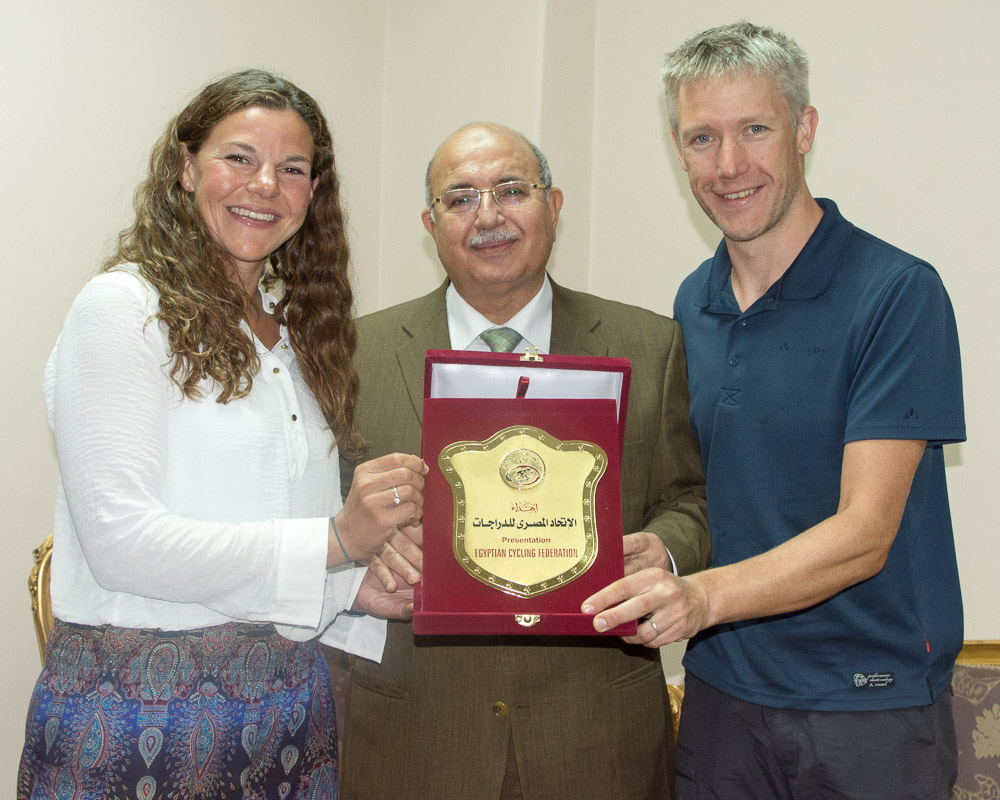
Dr Azzam, the Head of the African Cycling Federation, presents us with an award on behalf of the Egyptian Cycling Federation. I’ve hidden it in Emily’s panniers.
Dr Azzam and his team were busy with the final preparations for the Arabian Cycling Championship to be held in Sharm El Sheikh the following week but they spared time to take us out for dinner – and also to the wedding party of a colleague, where we witnessed some spectacular traditional dancing.
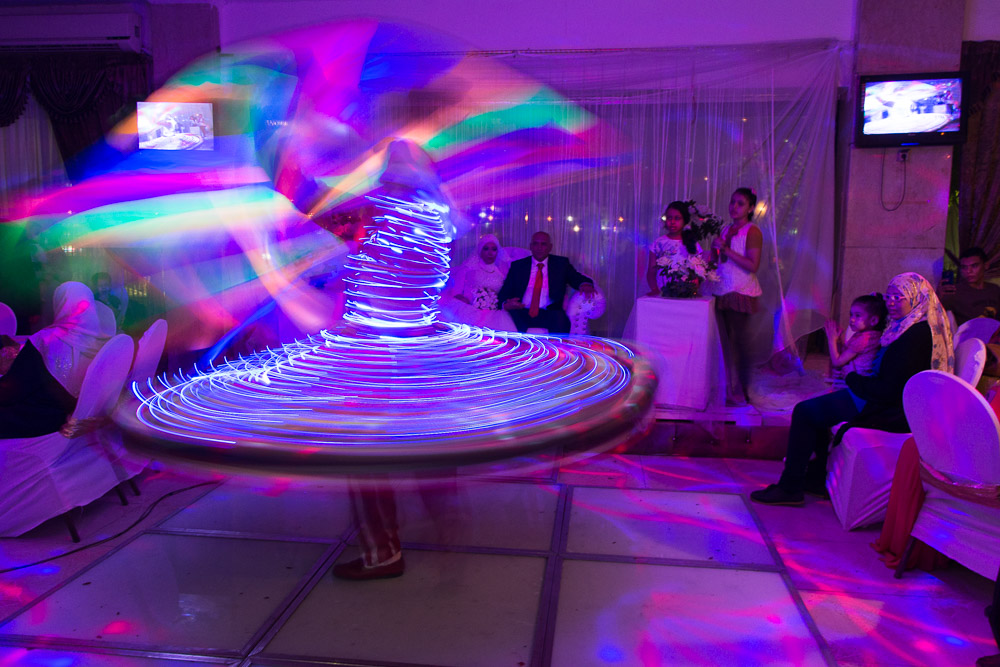
Spectacular dancing at an Egyptian wedding celebration
We’d based ourselves in a hotel close to the airport as we’d hoped we’d make a quick getaway to beat central Cairo’s traffic as soon as the visas came through. However, what was intended to be 4-night stop in Cairo turned into an 11-night frustration fest as we risked life and limb criss-crossing the capital in our frequent taxi trips to the Sudan embassy. Drivers in Cairo have absolutely no concept of any form of road rules whatsoever.
At the hotel, Emily made daily use of the gym whereas I was more content with shuttle runs between our breakfast table and the buffet. Annoyingly, we were both hit with upset stomachs later in the week – something for which I was not yet mentally prepared.
After 11 nights and still without any sign of securing a Sudan visa, we decided enough was enough and got back on the road.
We had a choice of routes from Cairo to take:
- My preferred route would have been the Western Desert road, which would have taken us deep into the desert visiting small oases towns along the way to re-join the Nile just south of Luxor. However, the current FCO travel advice ruled this out.
- Straight down the Nile. It would have been the shortest route but also the most populated because Egypt’s population is squeezed into a thin strip of land in the Nile valley. More people = more hassle.
- Head Southeast to Ain Sokhna. This option was ruled out because cyclists are banned from cycling the Cairo to Ain Sokhna road without special permission.
- West on the Cairo to Suez road then south along the Red Sea, heading inland at Safaga to Qena, just north of Luxor.
We opted to cycle the Cairo to Suez route. Although it was slightly longer, it meant we would delay the inevitable hassle along the Nile and also experience a taste of the desert on the Safaga to Qena road.
We left Cairo early on a Friday morning. It being the Sabbath, the roads were empty and it was great to see a few groups of local cyclists enjoying the wide-open highway.
Cairo is home to 20+ million people so space and accommodation is at a premium. When leaving the city we witnessed the government’s attempt to address this problem by building new cities on the outskirts of Cairo. Simply dubbing these huge suburban urban conurbations as ‘New’ Heliopolis and ‘New’ Cairo, they’re springing up at a rate of knots along the Cairo to Suez road.
After a couple of days break in Jordan and the Sudan visa debacle in Cairo, we’d had 15 days off the bikes and, boy, we soon paid the price. Although the terrain wasn’t hilly, a headwind kicked up and put our fitness to the test. Add to the equation the searing desert sun and the fact that, due to our upset stomachs, our bodies hadn’t retained sufficient liquids over the previous few days we started to suffer. I soon regretted my battles with the breakfast buffet.
We staggered into Suez at dusk, barely able to keep our bikes upright and our bodies from retching. Ironically, the easterly wind we’d been battling all day had flipped directions and, now blowing from the west, the strong wind kicked up a huge cloud of sand from the desert we’d just traversed, blackening the sky further. We could all but manage to stand up as we checked into our Suez hotel, where wedding celebrations and fireworks kept us awake all night.
Partially rehydrated and rested, we headed south the next day towards Zaafarana. The 107km ride took us along the Red Sea coast and there were plenty of touristy places to stop for water and snacks.
That all changed the next day, however, when we got our water strategy wrong. Some light drizzle had formed a few roadside puddles but, other than that, for the 100km between Zaafarana and Ras Ghareb there were no water sources at all. We’d been expecting a handful of resorts but there was nothing but a couple of army lookout towers where some bored guards were more than happy to chat and fill our Water-to-Go bottles for us. One guard said he’d been watching us approach for the last 45 minutes through his binoculars
Then something funny happened.
A few kilometers further on we spied two full and unopened bottles of Dasani water by the roadside. We gulped them down. Another 5km we found another couple of bottles, slightly squashed but with the seals intact. We put them in our panniers. We made the same discovery another 10km further on. Half an hour later we came across the source of this water miracle; a truck had pulled over and two men were desperately trying to haul their cargo back on to the truck and tie a tarpaulin over it.
They were carrying a cargo of Dasani water. The unexpected desert drizzle had soaked the cardboard packaging, which caused the bottles to fall from the weakened packaging.
Now, Dasani water was probably one of the biggest marketing flops the UK has ever seen. The Coca-Cola owned brand was abandoned after the ‘purified water’ with a 3,000% mark up was found to be nothing but filtered tap water – enabling the British press to liken it to Peckham Spring. The final nail in the brand’s coffin was when independent tests found higher-than-permitted levels of a potentially carcinogenic chemical in the water. Coca-Cola pulled Dasani from the UK market but the brand’s going strong in the rest of the world and, on this day, we were very grateful that these bottles had been ‘falling from the sky’ for us.
Later, the truck overtook us and we scooped up the bottled water for the rest of the afternoon.
Just after setting off on our last day along the Red Sea, Emily’s pannier rack fell off. We propped the bikes up against a large road sign. Whilst we were tinkering away with our sub-optimal adjustable spanner a 4-foot long snake darted by my feet and hid under between the concrete base and metal structure of the sign. We had no option but to continue fixing the pannier rack knowing that the serpent was inches away from our toes looking at our every move.
Seeing that we were trying to fix the bike, a guy stopped and leant us a spanner from his toolkit. He was a dive instructor at a nearby resort and introduced himself as “Humpty Dumpty”. I didn’t ask where that nickname had come from! Humpty was great and, with his spanner, we got the pannier rack fixed in minutes…although he became somewhat edgy when I told him about the snake just inches from where we were crouching!
We had the wind in our favour for the majority of our few days cycling the Red Sea coast and made it to Safaga, where we stocked up on supplies ahead of the 2-day cycle across the Eastern Desert from Safaga to Luxor.
Our first challenge on the Eastern Desert road was to avoid getting a police escort.
You see, police escorts outside the main tourist areas in Egypt are commonplace and we’ve read many accounts from touring cyclists that they are a hindrance more than help. Some have even given up cycling and hitched a lift with the police instead. They sit on your wheel, diesel engine rattling. They force you to stop when they want to stop and they rush you along when you want to stop. With little perceived threat in the area we wanted to avoid the police as much as possible. But, with countless checkpoints on the roads, it was going to be a challenge to get them to leave us to our own devices.
At the first checkpoint just outside Safaga, I think we managed to convince the police that we were going to cycle the full 170km to Qena in one day. I definitely think they would have followed us had they known we were planning to wild camp in the desert.
With that small victory behind us, we set off in to the unknown. Desert mountains either side of us and a gradual incline and a headwind made the going scenic but not easy. We supplemented the water we were carrying from a leaking roadside water pipe and, later, had lunch by the side of the road perched on rocks that were shaded from the relentless sun by a craggy outcrop above.
To our surprise there was a small shop selling drinks about a quarter of the way across and, where the map said ‘fuel stop’ at the halfway point there was a cluster of houses and shops all selling overpriced drinks.
The small village also meant more police checkpoints. It was now 4pm and, with just over an hour until sunset, we firmly believed we would be given a police escort or be forced to camp behind the police hut. However, whenever they asked us where we were going, we simply repeated “Qena” to the extent that, again, they were either convinced we were going straight there or they couldn’t be bothered following us because it was nearly their home time.
With our final police checkpoint of the day avoided, we ducked down a sandy bank out of sight of the road and set up our wild camp in the desert, enjoying the remote peacefulness of the desert in our tent for the first time.
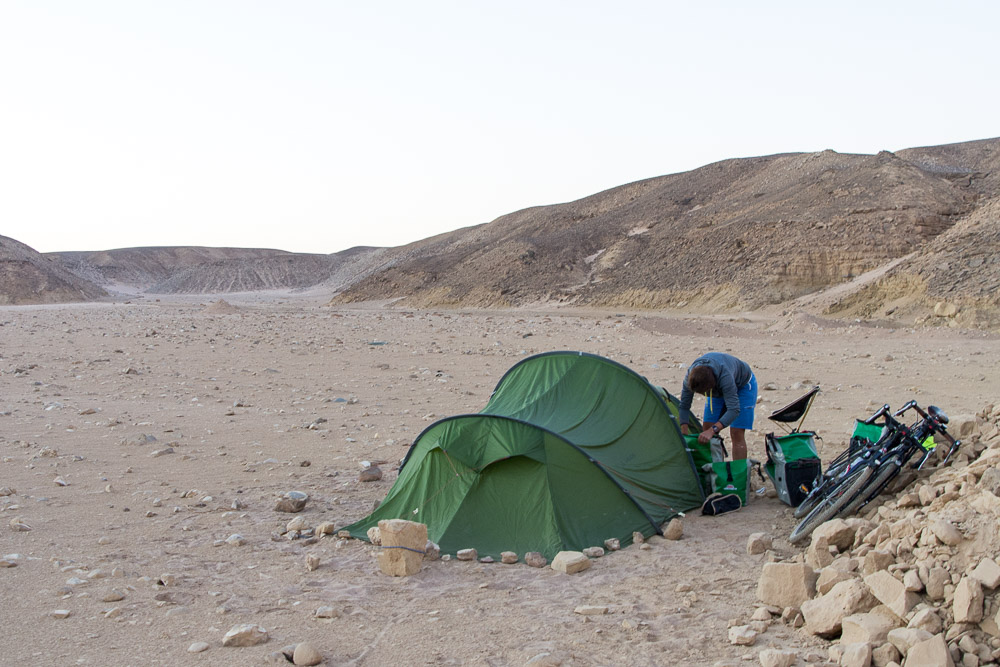
Taking the tent down after enjoying a peaceful night in the desert. Yes, we checked for snakes and scorpions!
We were up early the next morning to complete the desert stretch out of the heat. A few minutes after passing another police checkpoint 40 KM from Qena, we heard a diesel engine and looked round to see we had a police escort. They followed us, watched intently as we changed a puncture but then, once we’d passed through Qena they seemed to give up because they’d disappeared.
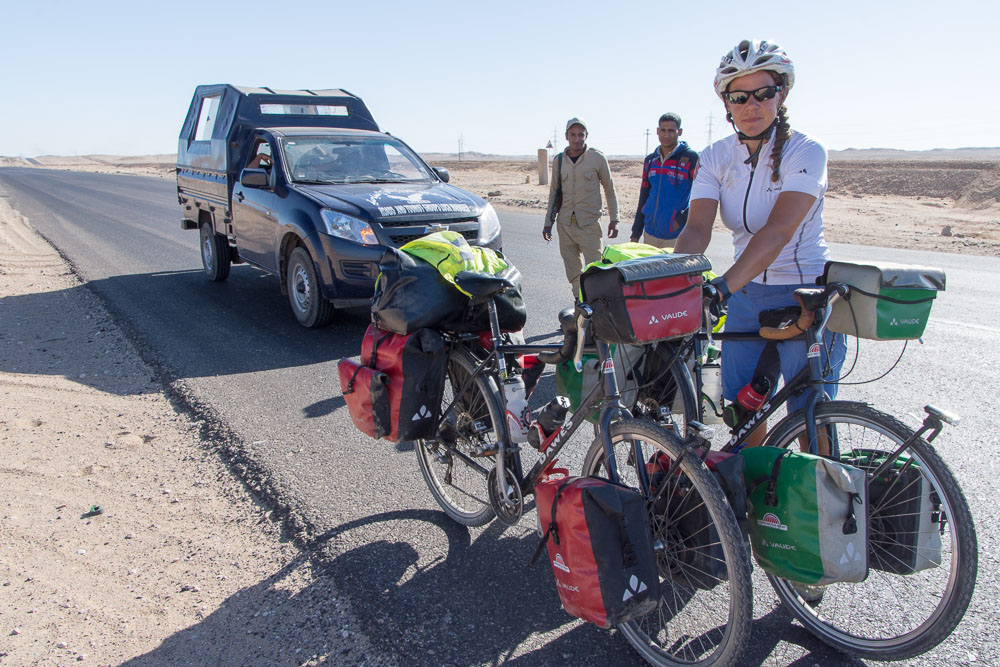
Our police kept a close eye on us as we changed a puncture – but gave up once we’d passed through Qena
It was an incredible experience to reach the fertile Nile Valley. Blasts of colour from vibrantly-coloured flowers and each plant seemed green-than-green after our days of cycling down the arid Red Sea and across the desert.
We continued for the rest of the day with only the constant shouts of “Hello” and “Welcome to Egypt” to contend with as we made our way to Luxor, where we took 2 days to see the world famous historic sites.
In Luxor we did something we’d never done before. We paid for a guide. And it was worth every penny. The knowledgeable chap took as around the Temple of Karnak, the Valley of the Kings and the Valley of the Nobles as well as other lesser-known tombs. All of which we would have simple skipped around and overlooked many interesting things. What’s more, the perceived troubles meant that tourists are keeping away, meaning we had the tourist sites pretty much to ourselves!
Our hotel in Luxor had a Tourist Policeman sat on the door. When it was time for us to leave, he again insisted that he call for a police escort. I negotiated that, instead of an escort, the police could take our number and call us at regular intervals to check how we’re doing. So, we set off south without an escort.
It was our first full day cycling down the Nile and we were instantly glad we’d taken the quieter Red Sea route up until now. Every person we passed shouted at us. Most shouted “Hello, What’s your name?” and “welcome to Egypt” whilst others shouted “money money money”.
The hassle escalated when we stopped at a bakery, which was next door to a school. I turned round to find Emily and our bikes surrounded by kids grabbing our bikes. I quickly got back on my bike but not before even more kids and adults joined the growing throng. One woman stood in the way of the bike and shouted at me when I tried to move it forward. Three times she purposefully stood in the way then got upset when I tried to move forward. We eventually escaped the crowd with the help of a couple of more sensible adults but out bikes were pushed from both sides as we cycled off.
Things got more sinister later that afternoon. We were being followed by two tuktuks. In one, kids were constantly shouting “money, money, money”. The other was making several close high-speed passes. This became nasty when the lad in the back produced a large iron chain, which he repeatedly threatened us with from the speeding tuktuk. The driver would pass us, drive up the road, turn round then take another headlong run at us…with a chain being dangled from the back seat. The final straw was when he decided to swing the chain out of the tuktuk at us narrowly missing our bikes and enough was enough. We stopped and I think the emotion of it all got the better of Emily who was clearly upset. Within moments of stopping, however, a group of builders came over to help by ensuring the tuktuks couldn’t pass them.
We couldn’t be sure whether there was any real intention to hurt or just intimidate us, but the whole experience was unnerving to say the least and made us wary of any vehicle approaching from behind for the rest of the day.
That night we stayed at a noisy hotel in Edfu and received our first two check up calls from the police – at 1:30am and 2am! Unbelievable.
The next day, we opted to continue on the quieter road on the west bank of the Nile. Again, we were expecting the police to trail us but there weren’t any checkpoints at all. We were about 45km in when we got the first call. In broken English, the policeman asked where we were. “We are going to Aswan” I replied. He asked what time we will leave Luxor. “We leave Luxor today to go to Aswan”.
After suitably confusing him, he hung up. I got another call 10 minutes later from another policeman demanding to know where we were. I told him I didn’t know where we were and that I didn’t know how many kilometers we had cycled. We had the police on our tails.
The western Nile road became less populated as the width of the arable land between the river and the desert became thinner. The road itself ducked in and out of the desert a few times; each time we returned the river we were greeted with bursts of green from the trees and crops on this valuable fertile strip in the middle of a desert.
With 40km more to cycle, we caught a small ferry from the west bank to the east bank of the Nile. A friendly chap called Khalid helped us out with the formalities and even paid our £1LE tickets for us!
Whilst on the ferry, my phone went again.
“I have been ordered to provide security for you. Are you on the desert road?” the policeman asked.
“We have been cycling on the desert road this morning” I truthfully but evasively answered.
I then turned my phone off.
So, for the rest of the run down to Aswan, we managed to evade the police as we felt perfectly safe.
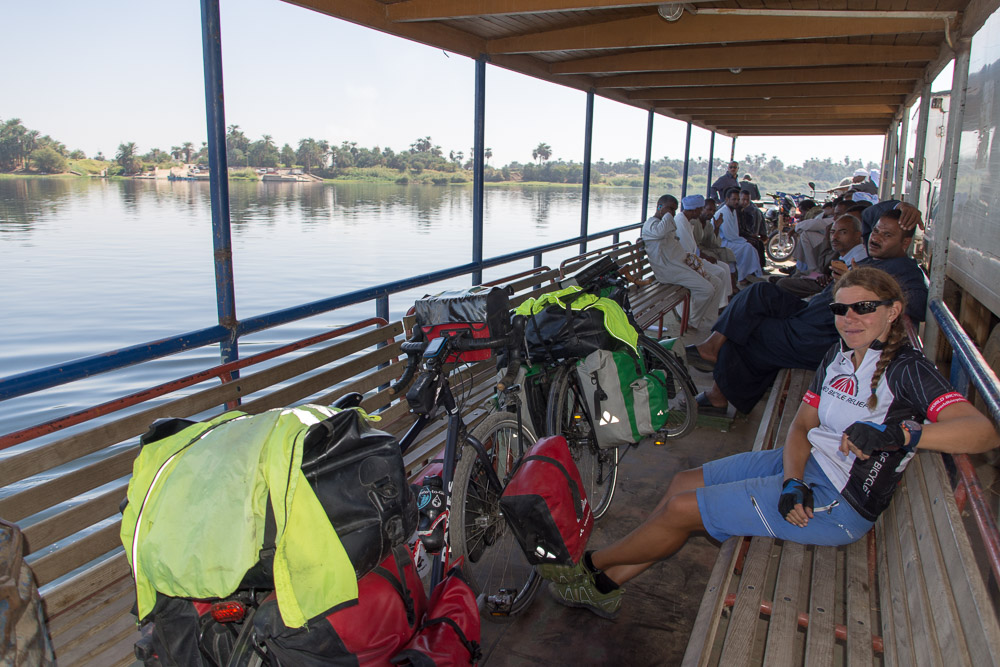
Escaping the police search party by crossing the Nile at Faris (Fars on road signs)
In Aswan we went to see Unfinished Obelisk, which lies in the same granite quarry from which Cleopatra’s Needle was hewn. It was extraordinary to visit this quarry from which most of Ancient Egypt’s famous granite statues came from. What’s more, it’s incredible to think about how on earth they managed to transport them across the country 5,000 years ago.
The Unfinished Obelisk was ordered by Hatshepsut (1508–1458 BC) and was to be the largest ever obelisk erected – at over 42 meters and 1,200 tonnes – had not a flaw in the granite been discovered at a late stage in its formation. After months of carving this huge monument directly from the bedrock by hand, the project had to be abandoned, leaving the thousands of workers as despondent and frustrated as two cyclists attempting to get a Sudanese visa from the embassy in Cairo.
On the subject of visas, we decided to reapply at the Sudanese consulate in Aswan. And our experience there could not have been any different from the debacle in Cairo. We were greeted warmly, guided through the forms (a different form altogether than Cairo), were told we needn’t bother with the ‘letter of introduction’ from our embassy or even put the details of a sponsor down (we did however give them both pieces of information). They took our US$50 each, kept our passports and told us to return “the day after tomorrow” where our visas would be ready “Inshallah”.
Now, ‘Inshallah’ (God Willing) is a catch-all get-out clause in the Islamic world but, in this case, we are 99% confident we can pick our visas up tomorrow – just 48 hours after re-applying.
Update: True to their word, we returned to the Sudanese consulate in Aswan today and, without any further questions, we were handed our passports with two visas firmly affixed inside. And, with tickets purchased for Sunday’s ferry from Aswan to Wadi Halfa, we are over the moon; but with a sightly bitter taste in our mouths from our experience in Cairo.
But for now, it’s time to say goodbye to Egypt. And, when we sip a celebratory beer alongside the Nile tonight watching the flocks of migratory birds that have been sweeping south across the sunset sky, we do so with the knowledge that we are now free to join them on their journey south.
But it’s not going to be an easy journey. As soon as we step off the ferry, we’ll face a A 1,200KM cycle across the Nubian and Bayuda deserts to Khartoum. It’ll be hot. It’ll be remote. But cycling Sudan is a challenge that we’re relishing.
If you’ve enjoyed reading this blog post, please donate to World Bicycle Relief. Every penny goes to the great work the charity does in Africa – not to fund our expedition in any way.

